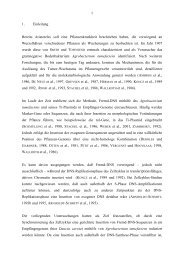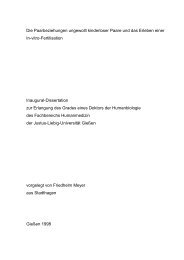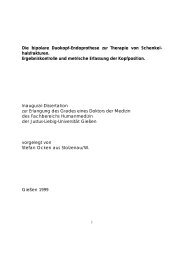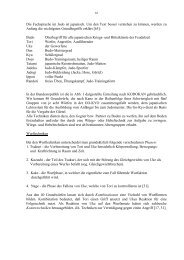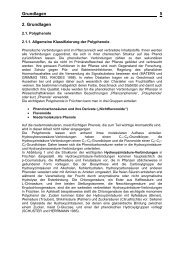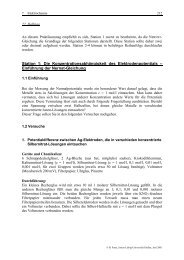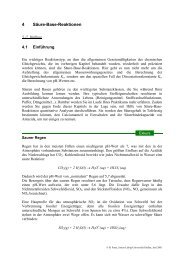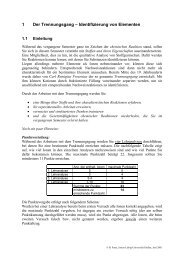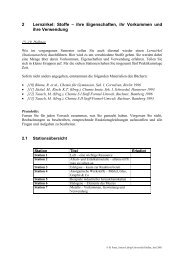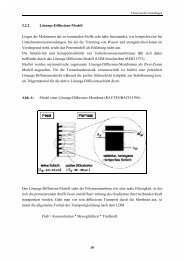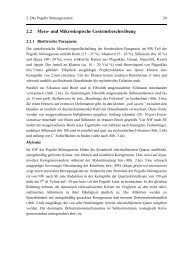Effects of diabaticity on fusion of heavy nuclei in the dinuclear model ...
Effects of diabaticity on fusion of heavy nuclei in the dinuclear model ...
Effects of diabaticity on fusion of heavy nuclei in the dinuclear model ...
Create successful ePaper yourself
Turn your PDF publications into a flip-book with our unique Google optimized e-Paper software.
explicitly assumed <strong>in</strong> <strong>the</strong> DNS <strong>model</strong> [34], which describes <strong>the</strong> experimental fusi<strong>on</strong> data quite<br />
well. The <strong>nuclei</strong> <strong>in</strong> <strong>the</strong> DNS could be h<strong>in</strong>dered to melt toge<strong>the</strong>r <strong>in</strong> R due to diabatic effects or<br />
due to a specific behaviour <str<strong>on</strong>g>of</str<strong>on</strong>g> <strong>the</strong> mass parameters.<br />
In this chapter we study <strong>the</strong> diabatic potentials for <strong>heavy</strong> nuclear systems as a functi<strong>on</strong><br />
<str<strong>on</strong>g>of</str<strong>on</strong>g> <strong>the</strong> el<strong>on</strong>gati<strong>on</strong> λ, <strong>the</strong> neck coord<strong>in</strong>ate ε and <strong>the</strong> mass asymmetric η us<strong>in</strong>g <strong>the</strong> method <str<strong>on</strong>g>of</str<strong>on</strong>g><br />
maximum symmetry with<strong>in</strong> <strong>the</strong> generalized TCSM [35]. In <strong>the</strong> previous calculati<strong>on</strong>s [57] a<br />
simplified versi<strong>on</strong> <str<strong>on</strong>g>of</str<strong>on</strong>g> <strong>the</strong> TCSM was used and <strong>the</strong> role <str<strong>on</strong>g>of</str<strong>on</strong>g> <strong>the</strong> neck coord<strong>in</strong>ate was not taken <strong>in</strong>to<br />
account. We will compare our results with nucleus-nucleus potentials obta<strong>in</strong>ed by us<strong>in</strong>g a double<br />
fold<strong>in</strong>g procedure for <strong>the</strong> nuclear <strong>in</strong>teracti<strong>on</strong>. The calculati<strong>on</strong>s are performed for <strong>the</strong> symmetric<br />
systems 90 Zr+ 90 Zr, 96 Zr+ 96 Zr, 100 Mo+ 100 Mo, 110 Pd+ 110 Pd, 130 Xe+ 130 Xe and 136 Xe+ 136 Xe.<br />
The asymmetric systems 110 Pd+ 136 Xe, 86 Kr + 160 Gd and 48 Ca+ 198 Hg are also studied. The<br />
applicability <str<strong>on</strong>g>of</str<strong>on</strong>g> <strong>the</strong> diabatic method will be discussed for collisi<strong>on</strong>s near <strong>the</strong> Coulomb barrier.<br />
3.1 The diabatic potential<br />
In a diabatic descripti<strong>on</strong> <strong>the</strong> nucle<strong>on</strong>s do not occupy <strong>the</strong> lowest free s<strong>in</strong>gle-particle levels as <strong>in</strong><br />
<strong>the</strong> adiabatic case, but rema<strong>in</strong> <strong>in</strong> <strong>the</strong> diabatic levels dur<strong>in</strong>g <strong>the</strong> collective moti<strong>on</strong> <str<strong>on</strong>g>of</str<strong>on</strong>g> <strong>the</strong> nuclear<br />
system. As a result, <strong>the</strong> diabatic potential energy surface is raised with respect to <strong>the</strong> adiabatic<br />
potential energy surface and new potential barriers for collective variables may appear. The<br />
values <str<strong>on</strong>g>of</str<strong>on</strong>g> <strong>the</strong>se barriers can be also estimated by calculati<strong>on</strong>s <str<strong>on</strong>g>of</str<strong>on</strong>g> <strong>the</strong> structural forbiddenness <str<strong>on</strong>g>of</str<strong>on</strong>g><br />
fusi<strong>on</strong> [36]. The c<strong>on</strong>cept <str<strong>on</strong>g>of</str<strong>on</strong>g> structural forbiddenness is based <strong>on</strong> <strong>the</strong> difference created by acti<strong>on</strong><br />
<str<strong>on</strong>g>of</str<strong>on</strong>g> <strong>the</strong> Pauli pr<strong>in</strong>ciple between <strong>the</strong> state <str<strong>on</strong>g>of</str<strong>on</strong>g> <strong>the</strong> compound nucleus and <strong>the</strong> state <str<strong>on</strong>g>of</str<strong>on</strong>g> <strong>the</strong> separated<br />
<strong>heavy</strong> <strong>nuclei</strong> [63].<br />
The total diabatic potential is def<strong>in</strong>ed as<br />
V diab(q) =V adiab(q)+∆V diab(q), (3.1)<br />
where <strong>the</strong> set <str<strong>on</strong>g>of</str<strong>on</strong>g> collective coord<strong>in</strong>ates <str<strong>on</strong>g>of</str<strong>on</strong>g> <strong>the</strong> system is denoted by q. The adiabatic potential<br />
energy<br />
=ELDM + VN + δEshell + δEpair − E Vadiab(q) CN<br />
LDM<br />
25<br />
(3.2)



